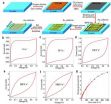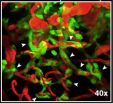(Press-News.org) The loss of eastern hemlock could affect water yield and storm flow from forest watersheds in the southern Appalachians, according to a new study by U.S. Forest Service scientists at the Coweeta Hydrologic Laboratory (Coweeta) located in Otto, North Carolina. The article was just published online in the journal Ecohydrology.
"Eastern hemlock trees have died throughout much of their range due to the hemlock woolly adelgid, an exotic invasive insect," said Steven Brantley, a post-doctoral researcher at Coweeta and lead author of the paper. "Though this insect has decimated whole stands of eastern hemlock along streams in the southern Appalachians, few studies have addressed the effects of this insect outbreak on landscape-level watershed processes such as stream flow."
Because of its dense evergreen foliage, eastern hemlock plays an important role in the water cycle of southern Appalachian forests, regulating stream flow year round. Although eastern hemlock rarely dominates the region's forests, the tree is considered a foundation species in the streamside areas called riparian zones.
Previous research by the Coweeta scientists led them to suspect that the loss of eastern hemlock would cause stream flow to increase over the short-term, especially in the dormant fall/winter season, then decrease over the longer term, with small effects annually. They also thought that peak flows after storms would increase, especially in the dormant season.
For this study, Coweeta researchers used a paired watershed approach—one watershed with a major hemlock component in the riparian forest area, the other reference watershed with very little—to determine the effects of hemlock mortality on stream flow and peak flow following storms. Since hemlock woolly adelgid was first detected in 2003, all the eastern hemlock trees in both watersheds died, resulting in a loss of 26 percent of forest basal area (that area occupied by tree trunks and stems) in the riparian area of the first watershed compared to a 4 percent loss in the reference watershed riparian forest.
"Instead of finding that stream flow increased after hemlock mortality, we found no real change in any year after infestation," said Brantley. "We did find, however, that peak stream flow after the largest storm events increased by more than 20 percent."
"The fact that hemlock loss didn't increase water yield in the short-term was due to the rapid growth response of co-occurring trees and shrubs in the riparian forests; and peak flows were likely higher after hemlock loss due to lower interception by the evergreen canopy in the riparian zone," said Brantley. "This latter finding suggests that riparian trees may play a disproportionally important role in regulating watershed processes than trees that aren't adjacent to the riparian zone."
"It also has implications for the more extreme rain events predicted under climate change," he added. "Losing foundation species in forested riparian zones could amplify the effects of altered precipitation regimes."
INFORMATION:
The study was conducted at the U.S. Forest Service Coweeta Hydrologic Laboratory, in the Nantahala Mountains of western North Carolina. Coweeta is one of the oldest continuous environmental studies in North America. Since 1934, precipitation, temperature, and stream flow have been continuously recorded at Coweeta, a U.S. Forest Service Southern Research Station facility.
Access the full text of the article at http://www.treesearch.fs.fed.us/pubs/46230.
For more information, email Chelcy Miniat at cfminiat@fs.fed.us.
Headquartered in Asheville, NC, the Southern Research Station is comprised of more than 120 scientists who conduct natural resource research in 20 locations across 13 southern states (Virginia to Texas). The Station's mission is "…to create the science and technology needed to sustain and enhance southern forest ecosystems and the benefits they provide." Learn more about the Southern Research Station at: http://www.srs.fs.usda.gov/.
Loss of eastern hemlock affects peak flows after extreme storm events
2014-08-12
ELSE PRESS RELEASES FROM THIS DATE:
Graphene-based planar micro-supercapacitors for on-chip energy storage
2014-08-12
The rapid development of miniaturized portable electronic devices, such as micro-electromechanical systems, microrobots and implantable medical devices, has stimulated intense demand for micro-scale power sources. Although miniaturized micro-batteries that store energy by redox reactions provide the most frequently used micro-power source for current portable electronics on chip, their limited lifetime (hundreds or thousands of cycles) and low power density rule out applications that require high power over a short timeframe.
Micro-supercapacitors (MSCs) with a short ...
Researchers prove stability of wonder material silicene
2014-08-12
An international team of researchers has taken a significant step towards understanding the fundamental properties of the two-dimensional material silicene by showing that it can remain stable in the presence of oxygen.
In a study published today, 12 August, in IOP Publishing's journal 2D Materials, the researchers have shown that thick, multilayers of silicene can be isolated from its parent material silicon and remain intact when exposed to air for at least 24 hours.
It is the first time that such a feat has been achieved and will allow scientists to further probe ...
Prognosis of pneumonia: value of respiratory rate often overlooked
2014-08-12
Pneumonia – a severe lung infection – is the most common disease calling for hospital admission. More than one out of ten pneumonia patients die of the disease. Thus it is vital to accurately predict and closely monitor the clinical course. Here, measuring the respiratory rate – the number of breaths a person takes in a minute – provides valuable information. However, far too little use is still being made of this vital sign in clinical practice, as Richard Strauß and co-authors conclude in their recent study in Deutsches Ärzteblatt (Dtsch Arztebl Int 2014; 111: 503).
The ...
Hijacking the brain's blood supply: tumor discovery could aid treatment
2014-08-12
ANN ARBOR, Mich. — Dangerous brain tumors hijack the brain's existing blood supply throughout their progression, by growing only within narrow potential spaces between and along the brain's thousands of small blood vessels, new research shows for the first time.
The findings contradict the concept that brain tumors need to grow their own blood vessels to keep themselves growing – and help explain why drugs that aim to stop growth of the new blood vessels have failed in clinical trials to extend the lives of patients with the worst brain tumors.
In fact, trying to ...
Lead released from African cookware contaminates food
2014-08-12
San Francisco and Yaoundé – Lead levels in foods prepared in aluminum pots from Cameroon exceed U.S. guidelines for lead consumption according to a new study published this month. A typical serving contains almost 200 times more lead than California's Maximum Allowable Dose Level (MADL) of 0.5 micrograms per day.
Researchers at Ashland University and Occupational Knowledge International tested 29 samples of aluminum cookware made in Cameroon and found almost all had considerable lead content. This cookware is common throughout Africa and Asia and is made from recycled ...
Changes in motor function in the unaffected hand of stroke patients should not be ignored
2014-08-12
With effective rehabilitation, stroke patients can partially regain their motor control and continue their activities of daily living. Motor function changes in the unaffected hand of stroke patients with hemiplegia. However, these changes are often ignored by clinicians owing to the extent of motor disability of the affected hand. Research group at Shanghai University of Sport, China led by Prof. Zhusheng Yu based on finger tapping frequency and Lind-mark hand function score have found that the motor function of unaffected hands in stroke patients was poorer than that ...
Neuroprotective effect of tongxinluo: a PET imaging study in small animals
2014-08-12
Tongxinluo has been widely used in China for the treatment of acute stroke and for neuroprotection. Research group at Encephalopathy Center, Guangdong Provincial Hospital of Traditional Chinese Medicine, China intragastrically administered Tongxinluo superfine powder suspension or its vehicle to rats for 5 successive days before middle cerebral artery occlusion. There are many advantages of using small animal PET for drug research. First, the results of the study in vitro cannot be directly applied to human studies, while small animal PET imaging methods and results can ...
ASU-Mayo researchers use calcium isotope analysis to predict myeloma progression
2014-08-12
TEMPE, Ariz. – A team of researchers from Arizona State University and Mayo Clinic is showing how a staple of Earth science research can be used in biomedical settings to predict the course of disease.
The researchers tested a new approach to detecting bone loss in cancer patients by using calcium isotope analysis to predict whether myeloma patients are at risk for developing bone lesions, a hallmark of the disease.
They believe they have a promising technique that could be used to chart the progression of multiple myeloma, a lethal disease that eventually impacts ...
Neutrino detectors could help curb nuclear weapons activity
2014-08-12
Physicists at the Large Hadron Collider in Switzerland and even in the fictional world of CBS' "The Big Bang Theory" look to subatomic particles called neutrinos to answer the big questions about the universe.
Now, a group of scientists led by a physics professor with the College of Science at Virginia Tech are asking whether the neutrino could provide the world with clues about nuclear proliferation in Iran and other political hotspots.
Neutrinos are produced by the decay of radioactive elements, and nuclear reactors produce large amounts of neutrinos that cannot ...
Focal blood-brain-barrier disruption with high-frequency pulsed electric fields
2014-08-12
A team of researchers from the Virginia Tech-Wake Forest University School of Biomedical Engineering and Sciences have developed a new way of using electricity to open the blood-brain-barrier (BBB). The Vascular Enabled Integrated Nanosecond pulse (VEIN pulse) procedure consists of inserting minimally invasive needle electrodes into the diseased tissue and applying multiple bursts of nanosecond pulses with alternating polarity. It is thought that the bursts disrupt tight junction proteins responsible for maintaining the integrity of the BBB without causing damage to the ...



